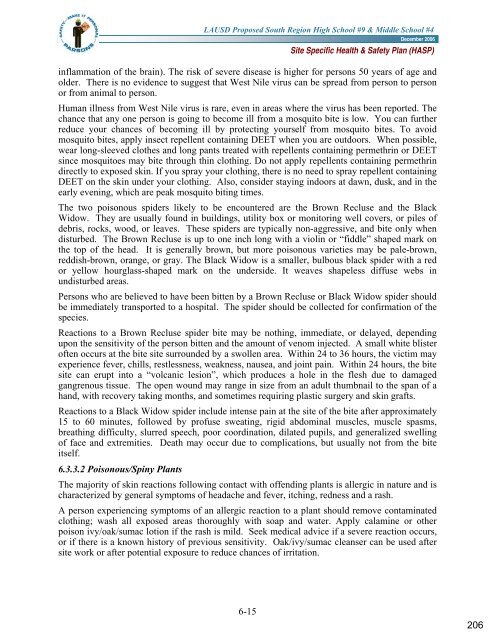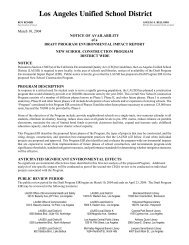Site-Specific Health and Safety Plan (HASP) - Laschools.org
Site-Specific Health and Safety Plan (HASP) - Laschools.org
Site-Specific Health and Safety Plan (HASP) - Laschools.org
Create successful ePaper yourself
Turn your PDF publications into a flip-book with our unique Google optimized e-Paper software.
LAUSD Proposed South Region High School #9 & Middle School #4<br />
6-15<br />
December 2006<br />
<strong>Site</strong> <strong>Specific</strong> <strong>Health</strong> & <strong>Safety</strong> <strong>Plan</strong> (<strong>HASP</strong>)<br />
inflammation of the brain). The risk of severe disease is higher for persons 50 years of age <strong>and</strong><br />
older. There is no evidence to suggest that West Nile virus can be spread from person to person<br />
or from animal to person.<br />
Human illness from West Nile virus is rare, even in areas where the virus has been reported. The<br />
chance that any one person is going to become ill from a mosquito bite is low. You can further<br />
reduce your chances of becoming ill by protecting yourself from mosquito bites. To avoid<br />
mosquito bites, apply insect repellent containing DEET when you are outdoors. When possible,<br />
wear long-sleeved clothes <strong>and</strong> long pants treated with repellents containing permethrin or DEET<br />
since mosquitoes may bite through thin clothing. Do not apply repellents containing permethrin<br />
directly to exposed skin. If you spray your clothing, there is no need to spray repellent containing<br />
DEET on the skin under your clothing. Also, consider staying indoors at dawn, dusk, <strong>and</strong> in the<br />
early evening, which are peak mosquito biting times.<br />
The two poisonous spiders likely to be encountered are the Brown Recluse <strong>and</strong> the Black<br />
Widow. They are usually found in buildings, utility box or monitoring well covers, or piles of<br />
debris, rocks, wood, or leaves. These spiders are typically non-aggressive, <strong>and</strong> bite only when<br />
disturbed. The Brown Recluse is up to one inch long with a violin or “fiddle” shaped mark on<br />
the top of the head. It is generally brown, but more poisonous varieties may be pale-brown,<br />
reddish-brown, orange, or gray. The Black Widow is a smaller, bulbous black spider with a red<br />
or yellow hourglass-shaped mark on the underside. It weaves shapeless diffuse webs in<br />
undisturbed areas.<br />
Persons who are believed to have been bitten by a Brown Recluse or Black Widow spider should<br />
be immediately transported to a hospital. The spider should be collected for confirmation of the<br />
species.<br />
Reactions to a Brown Recluse spider bite may be nothing, immediate, or delayed, depending<br />
upon the sensitivity of the person bitten <strong>and</strong> the amount of venom injected. A small white blister<br />
often occurs at the bite site surrounded by a swollen area. Within 24 to 36 hours, the victim may<br />
experience fever, chills, restlessness, weakness, nausea, <strong>and</strong> joint pain. Within 24 hours, the bite<br />
site can erupt into a “volcanic lesion”, which produces a hole in the flesh due to damaged<br />
gangrenous tissue. The open wound may range in size from an adult thumbnail to the span of a<br />
h<strong>and</strong>, with recovery taking months, <strong>and</strong> sometimes requiring plastic surgery <strong>and</strong> skin grafts.<br />
Reactions to a Black Widow spider include intense pain at the site of the bite after approximately<br />
15 to 60 minutes, followed by profuse sweating, rigid abdominal muscles, muscle spasms,<br />
breathing difficulty, slurred speech, poor coordination, dilated pupils, <strong>and</strong> generalized swelling<br />
of face <strong>and</strong> extremities. Death may occur due to complications, but usually not from the bite<br />
itself.<br />
6.3.3.2 Poisonous/Spiny <strong>Plan</strong>ts<br />
The majority of skin reactions following contact with offending plants is allergic in nature <strong>and</strong> is<br />
characterized by general symptoms of headache <strong>and</strong> fever, itching, redness <strong>and</strong> a rash.<br />
A person experiencing symptoms of an allergic reaction to a plant should remove contaminated<br />
clothing; wash all exposed areas thoroughly with soap <strong>and</strong> water. Apply calamine or other<br />
poison ivy/oak/sumac lotion if the rash is mild. Seek medical advice if a severe reaction occurs,<br />
or if there is a known history of previous sensitivity. Oak/ivy/sumac cleanser can be used after<br />
site work or after potential exposure to reduce chances of irritation.<br />
206







